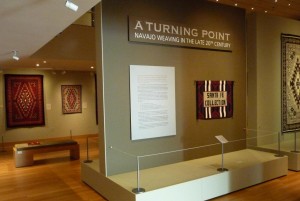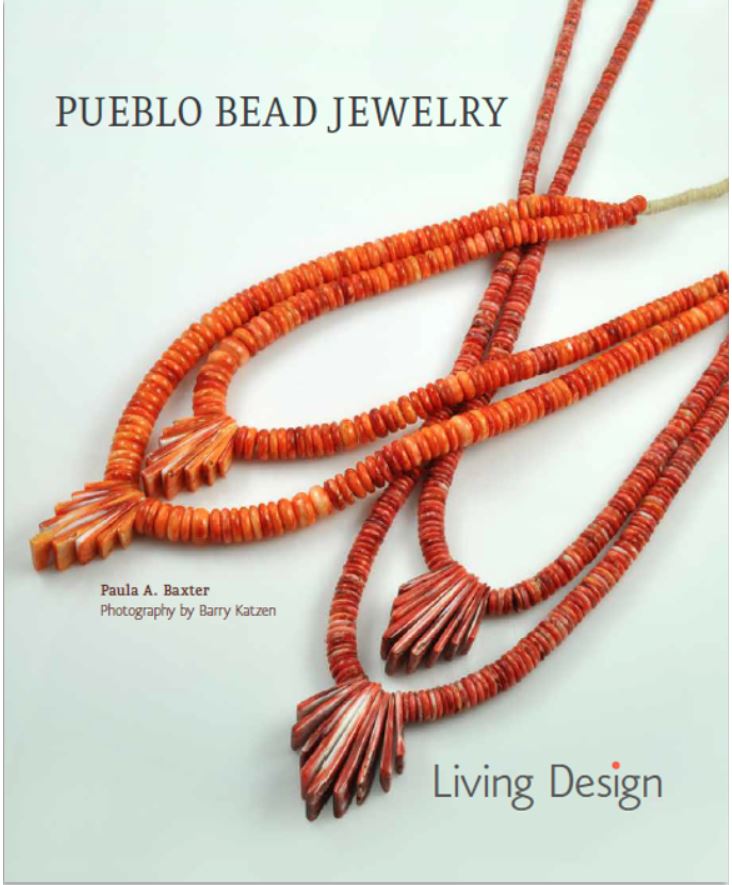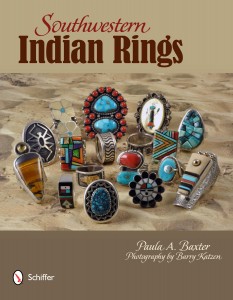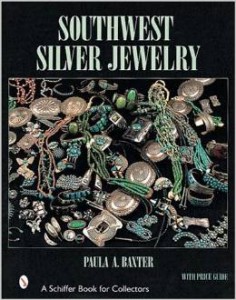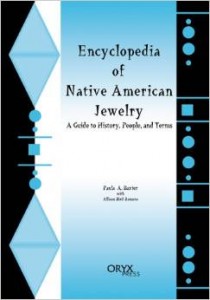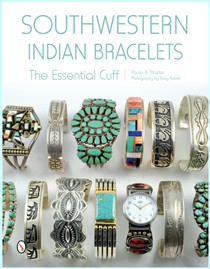With nearly thirty years of Indian Country travel behind us, one place always brings a smile. If we decide to travel to Teec Nos Pos, a trading post in Apache County, Arizona, we know our experience will be a good one. The original trading post was started in 1905, but the one we go to nowadays was rebuilt near the intersection of US Highways 160 and 64 after a fire in 1959. The name translates to “Cottonwoods in a Circle.” The trading post does utilitarian duty as a supplier for local Navajo families. Its rug room on the far right side has brought us rewards over the years. The Teec Nos Pos style of Navajo weaving is almost “Oriental” in its intricate designs; we have, however, also found fine pictorial weavings here, including my “Merry Christmas” piece.
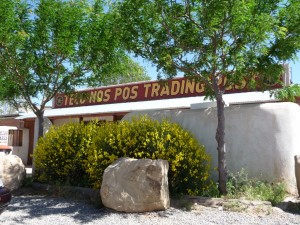 Teec Nos Pos Trading Post
Teec Nos Pos Trading Post
One time after a bad case of salmonella rendered me incapable of making Mesa Verde’s holiday celebration, we drove to Teec in search of a restorative. An hour in the rug room banished all aches and pains. XE3G7GEHUBES
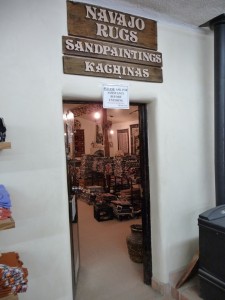 The entrance to the trading post’s Rug Room.
The entrance to the trading post’s Rug Room.
Navajo weavings are a wonderful category of Indian-made art. These textiles, old and new, bear testimony to the artist’s eye for small details that pack a punch. Like clouds and scenes from reservation life, a weaving can come alive when animals are introduced. The tree of life weavings come to mind at once, but then there are those compositions that portray the sturdy chipmunk, carefree Kaibab squirrel, or anxious cottontail. One of my favorite categories is the pictorial weaving, where the introduction of animals makes the entire composition that much livelier. We were fortunate in the late 1980s to obtain a small weaving by the artist Fanny Pete that consists entirely of rabbits! It’s the pride of our home and I’d never let our amazingly spoiled bunnies anywhere near it. For those of you unacquainted with domestic rabbits—they chew textiles like puppies…
For the third time, we tried to visit Toadlena Trading Post and failed. We attempted two times back in the mid-to-late 1990s when we were doing our roving trading post visits. We found Two Grey Hills on the dirt road, but no luck when it came time to sight Toadlena. On our recent visit last month, we were traveling on Route 491 (former Rte. 666) from Gallup to Shiprock and back. We knew the turnoff was around Newcomb, we had our maps out, and there were some signs not far out of both Gallup and Shiprock. Yet we failed again.
The culprit, we realized, was the fact that New Mexico DOT is working on Route 491 in that area, doing bypass construction and road widening. Subsequently, the turnoff from 491 wasn’t indicated. We’ve been pretty excited about the work that Mark Winter and staff have been doing to make this 1890s trading post come alive again with weaving talent and the chance for the visitor to have an artful museum experience. Nevertheless, a well-placed sign at the turnoff would help everyone. Maybe the construction workers moved it. We’ll try to find this elusive trading post yet again on a later trip. In the meantime, if you plan to visit — get your GPS going!
Face it, we all like dinosaurs. I remember being a little girl in the later 1950s and early 1960s running around lisping that I wanted to be a paleontologist and that the stegosaurus was my favorite animal. William Andrew Pacheco (Santo Domingo) understands this passion, and the dinosaurs roaming his monumental pottery pieces come from a shared love of these doomed creatures.
I know collectors who seek out dinosaur fetish carvings. (A hint: Turquoise Village in Zuni often has a small box of older dinosaur carvings among its wonderful trays of fetishes shelved by animal.)
Indian Country also abuts places where the richest dinosaur findings have been made. Contemporary dinosaur carvings can even show indications of feather tufts, the latest discovery in a far from stodgy field.
My husband has long wanted a dinosaur Navajo pictorial weaving of dinosaurs — a “Jurassic rug” as it were — but due to the work involved (the detail and non-repetitive patterns) these are quite rightly among the highest priced examples of the craft. So he’s been saving up… .
One of the best things about Native-made textiles is in the detail. Today’s weavers use opportunities to pull the viewer in with a small touch. Such an image is often organic, ranging from rain clouds to rabbits. Don’t forget to check out the Crownpoint Rug Auctions if you plan to be in western New Mexico.
Exhibitions like “A Turning Point,” currently at the Heard Museum, point out essential information. Navajo weavings are famed for their unexpected narrative elements, usually in keeping with the overall design.
One of the highlights of attending the Heard Museum Guild Indian Fair and Market, which seemed to be bigger and better than in previous years, was the museum’s exhibition, A Turning Point: Navajo Weaving in the Late 20th Century. Shows like these help collectors and interested people to pinpoint artistic trends and development. For a craft rooted in the nineteenth century, Navajo weaving has come a long way. Discoveries include:
- use of popular culture references, such as brands
- titles for certain compositions
- inclusion of rugs within other rugs to create a “framing” concept
- weavers’ pathways as significant elements
The Storm Pattern rugs were the most vivid standouts in this great exhibition.
